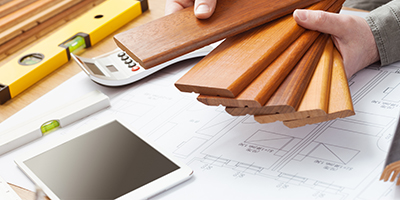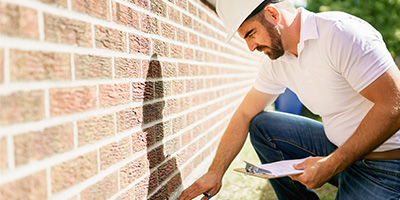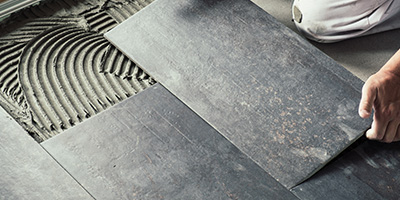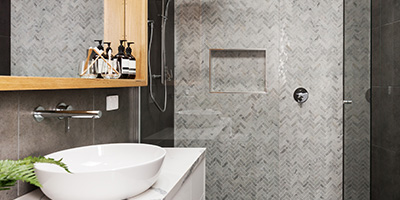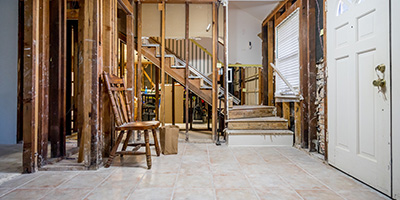How to Demo a Bathroom From Top to Bottom
We'll tell you how to get your bathroom down to four walls so you can build it back up the way you want.
Make cleanup a breeze with a roll off dumpster:
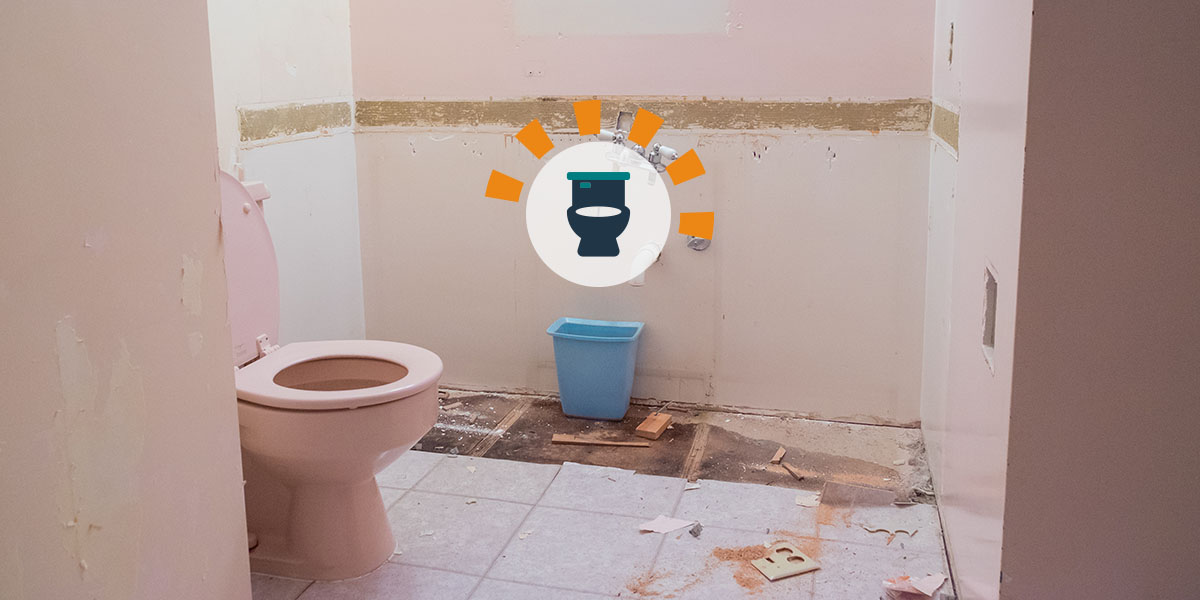
A DIY Guide to Bathroom Demolition
Outdated tile getting you down? Want to trade in your tub for a sleek open shower? Before you can get the bathroom you want, you need to get rid of the one you have. If you’re hiring a pro to handle the remodel, making your bathroom demolition a DIY job is a great way to save some money on your project budget. It’s strenuous work, but it doesn’t take any special skills. Most homeowners can accomplish it using simple tools you probably already own.
Bathroom Demo FAQs
Can I demo my own bathroom?
Yes, anyone can demo their own bathroom. However, be sure you know what you're doing before you get to work. If there are any aspects of the job that you're unsure about, have a backup plan in mind or consult a professional.
Is a dumpster necessary for a bathroom demolition?
Tearing a bathroom down involves a lot of debris -- some of which can be sharp or hazardous. Having a roll off dumpster onsite to handle the demolition debris will help keep your work space clear of unneeded debris and safe to work at.
Ready to rent a dumpster? Order online today.
In what order do you demo a bathroom?
While each bathroom is different, you'll generally want to demo your bathroom in this order:
- Shut off utilities: This step should always come first.
- Remove fixtures: It usually helps to start with the fixture that will give you the most usable space.
- Tear out walls and floors: Which comes first depends on if the walls go over your floor.
How much does it cost to demo a bathroom?
The average bathroom demolition costs between $500-$2,000. The wide range is due to a number of factors including the size of the bathroom, the number of fixtures, the type of bathtub or shower and the location of the bathroom in the home.
Order a Dumpster Online
Shopping after hours? Too busy to make another call? Book the dumpster you need, when you need it. Order your dumpster online 24/7.
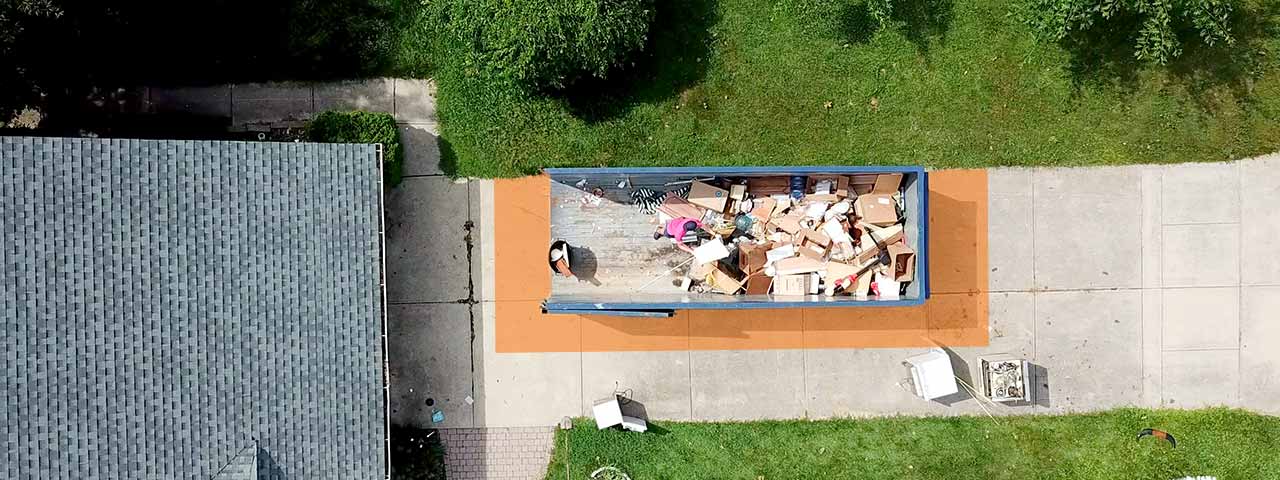
Step 1: Prep the Bathroom
While bathroom demolition is a project that's well within the ability of any DIYer, it's a big undertaking. To set yourself up for success in the long-run, you'll want to check off a few prep items before you get to tearing things out. From the tools you need to shutting off utilities, we've got you covered.
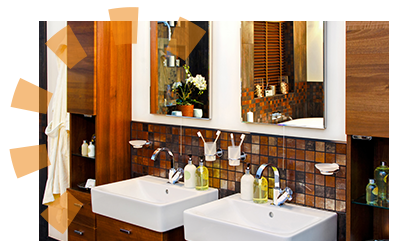
Gather Your Tools
While there are a few items that you may need to rent from your local Home Depot or Lowe's, most bathroom demolition tools, supplies and safety gear can be found in a standard tool kit.
/////Tools | /////Supplies & Safety Gear |
|---|---|
Pliers | Rags |
Chisel | Bucket |
Jig Saw | WD-40 |
Pry Bar | Duct Tape |
Hammer | Face Mask |
Shop-Vac | Work Gloves |
Utility Knife | Sturdy Boots |
Screwdriver | Plastic Sheets |
Reciprocating Saw | Safety Goggles |
Adjustable Wrench | Long Pants and Sleeves |
Need a dumpster to handle the mess?
Get a Price and Place Your Order Give Us a Call to Learn More
Clear Out the Little Stuff
Completely clean out your vanity, linen cupboard, shower, and shelves or other storage areas before you start your bathroom demo. This is a good opportunity to do some light bathroom organization, so throw out what you no longer use and donate anything in good condition. Move whatever you’re keeping to another room.
Remove Anything on the Walls
Next, take down your mirror to prevent damage while the hammers are swinging. If there are any shelves or cabinets to remove, but you plan to reuse them in your new design, tear them off carefully and store them somewhere out of the way.
Shut Off Utilities
It’s almost time to start the real work of gutting your bathroom. But first let’s make the room safe to work in.
Shut off power to the bathroom by finding the right switch in your breaker box and flipping it to the ‘off’ position. Your breaker box should have a circuit map showing which switch controls the bathroom, but if not, you’ll have to use good old trial-and-error.
Depending on how your plumbing is set up, there are a couple different ways to shut off the water supply.
If you have a manifold supply system:
- Find the manifold lines near your main water supply line.
- Identify the line for the bathroom. Each line should be clearly marked.
- Use the manifold key to turn the valve on the bathroom’s line to the ‘off’ position.

Keep in Mind
If you can’t turn the key, don’t force it. Too much force can break the valve and flood your bathroom. Instead, turn off water to your whole house at the main water line.
If you have copper piping:
- Find the valve for your sink under the vanity and turn it off.
- Turn off the toilet valve, located on the wall or floor behind the toilet.
- Find the access panel for your shower line, usually located in the wall behind the shower. Turn the valve to the ‘off’ position.
If you can’t access the valves for your bathroom fixtures, are unable to find the bathroom line on your manifold system, or have any other issues, turn the main water supply valve to the ‘off’ position to shut off water to your entire house.
Drain Water from Faucets and Toilet
To prevent a small-scale flood while you’re working, drain any water that’s left in your pipes after shutting off the water supply.
Turn on all faucets in the bathroom until water stops running.
Flush the toilet to drain the tank and bowl. Use a small cup or sponge to get rid of any water left behind. You can also use a wet/dry vac for water left after you flush.
Rent a Dumpster
Before you break out the tools, rent a residential dumpster to clean up as you work. Between your sink, vanity, tub, toilet, tile and backing, gutting a bathroom will leave you with way more mess than you can set at the curb. And even if you do, your trash service won’t take it.
If you’re not up for making several trips to the dump yourself, you’ll need a roll off container to avoid becoming that house with a toilet pulling double duty as a lawn ornament.
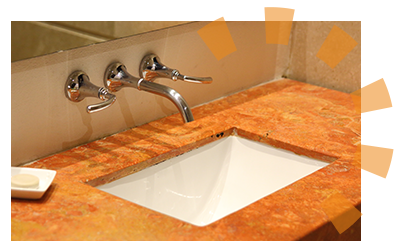
Step 2: Tear Out Sink and Vanity
Time to start the real demo work. The only tools you’ll need for this step are a bucket, an adjustable wrench and a utility knife. However, full-sized vanities can be very heavy. So it might not be a bad idea to have a friend on-hand to help.
Get a more detailed walk-through of this step in our DIY vanity removal guide
How to Demolish a Bathroom Vanity:
- Put a bucket under the sink drain to catch any water in the drain trap.
- Use an adjustable wrench to unscrew the nuts around the u-shaped section of pipe, called the P-trap, under your sink. Dump any water caught in the P-trap into your bucket.
- Unscrew the nuts where the sink’s water supply lines come through the wall.
- Check behind the sink for any bolts or brackets connecting it to the wall. Remove any that you find and lift the sink out.
- If your sink rests on the vanity, pull it straight up and out. Sinks can be heavy, so have a helper on standby.
- Unscrew bolts connecting the vanity to the wall or use your utility knife to cut through any caulk. Pull the vanity out.
- Toss the debris in your dumpster so you have room to work safely on the next steps.
Step 3: Remove the Toilet
Tearing out a toilet is slightly more involved than removing your vanity, but it’s still a straightforward task for a DIY bathroom demolition.
You’ll need an adjustable wrench and a utility knife. If your toilet has been in place for a long time, you may also need some WD-40 and a socket wrench.
Get a more detailed walk-through of this step in our one-stop guide to removing a toilet
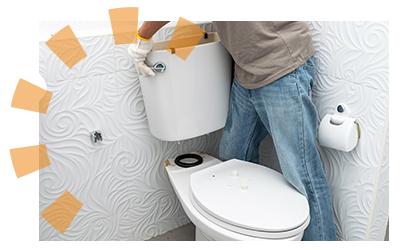
How to Remove a Toilet:
- Find the threaded pipe located under the toilet tank, called the inlet supply pipe. Unscrew the pipe from the tank and from the supply line valve on the floor or wall behind the toilet.
- Lift the tank from the toilet base and set it aside if your toilet is a two-piece model.
- Remove the nuts and bolts attaching the base to the floor with your adjustable wrench. If they’re stuck, spray on some WD-40 and use a socket wrench to ratchet them loose.
- Cut through any caulk around the toilet base with a utility knife and lift the toilet off the flange bolts.
- Use your utility knife to scrape away the wax around the drain flange in the floor. Unscrew the flange and remove it.
- Stuff rags in the drain hole to keep sewer gases from filling the bathroom while you finish your demo work.
- Carry everything to the dumpster to make room for the next task.
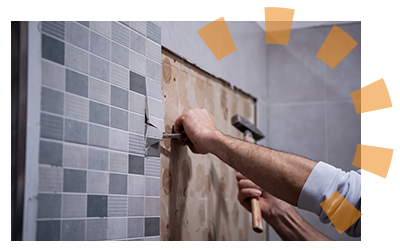
Step 4: Take Down the Tile
This is the most strenuous job in any bathroom demo, but luckily it’s not complicated. This step will probably take a full day, and you should never rush the work. Take breaks whenever you need so you can stay focused — and safe.
Before you start, prep the room by duct-taping plastic sheeting over all vents, registers and the door.
Get a more detailed walk-through of this step in our how-to guide to DIY tile removal

Safety Tip
If your home was built before 1978, test your bathroom walls for lead before starting tile demolition. If lead is present, hire a pro to avoid exposing your family to extremely harmful dust.
How to Demo Bathroom Tile:
- Use a hammer and chisel to chip away a vertical line of tile, starting at the rounded tiles on the edge of your shower.
- Do the same in a horizontal line for the tile along top of your shower.
- Use a reciprocating saw to cut through the exposed drywall, being careful not to cut into studs.
- Insert a pry bar into these seams and begin prying down sections of the tile and backing.
- Work your way around the room using this process for all tiled areas.
- Make sure you always have firm footing and that you know where any helpers are before you swing your hammer.

Keep in Mind
Take frequent trips to the dumpster while you work so you don’t risk tripping on loose tile. Use a Shop-Vac to suck up excess dust to avoid a slipping hazard.
Step 5: Tear Out the Bathtub or Shower
Your DIY bathroom demolition is almost complete. All that remains is to get rid of the bathtub or shower. The good news is that, while this step may require help for the heavy lifting, it’s fairly simple. So get your toolkit ready — you'll need a lot of them to complete this step.
Get more detailed walk-throughs in our guides to DIY bathtub removal and shower removal
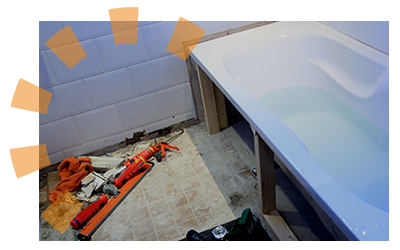
How to Remove a Bathtub:
Grab your screw driver, utility knife, drywall saw, jig saw and pry bars and get to work.
- Use a drywall saw to cut through the drywall surrounding the tub to a height of about 8 inches, if it didn’t already come down in the last step. Be careful not to cut into studs.
- Unscrew any screws securing the tub to wall studs.
- Cut through any caulk between the tub and floor with your utility knife.
- Pry the tub a few inches away from the wall.
- Use a jigsaw to cut the tub into two pieces. If your tub will fit through your doors in one piece, you can skip this step, but cutting it will make it easier and safer to carry.
- Work with a helper to pry each piece up and pull it out.
- Carry each piece to the dumpster.
How to Remove a Shower:
Gather your wrench, pliers, screwdrivers, pry bars, utility knife, reciprocating or jig saw and a hammer and get ready to make a mess.
- Use a screwdriver to remove hinges on the shower door, then set the door aside.
- Unscrew or pry out fasteners holding the door frame in place, then pull the frame off. You may need your utility knife to cut through caulk.
- Detach fixtures like the shower head and arm, water control knobs or levers, drain covers, soap holders or towel racks.
- Cut your shower walls into manageable pieces using your reciprocating or jig saw. For tile showers, pry off rows of tiles in order to cut each wall in half. For fiberglass showers, cut each wall at the corner and base so you have three pieces and a floor.
- Pry the shower floor loose and remove.
What Comes After a Bathroom Demolition?
Now that the hard work of demolishing your bathroom is done, it’s time to have a really good stretch — and probably a nap. When you wake up, don’t forget to turn the water back on!
Need some help planning your renovation? Check out our advice for avoiding common mistakes.
What Do You Think?
What was the hardest part of your demolition? We're listening. Head over to Twitter or Facebook,
and use #dumpstersblog to join the conversation.

